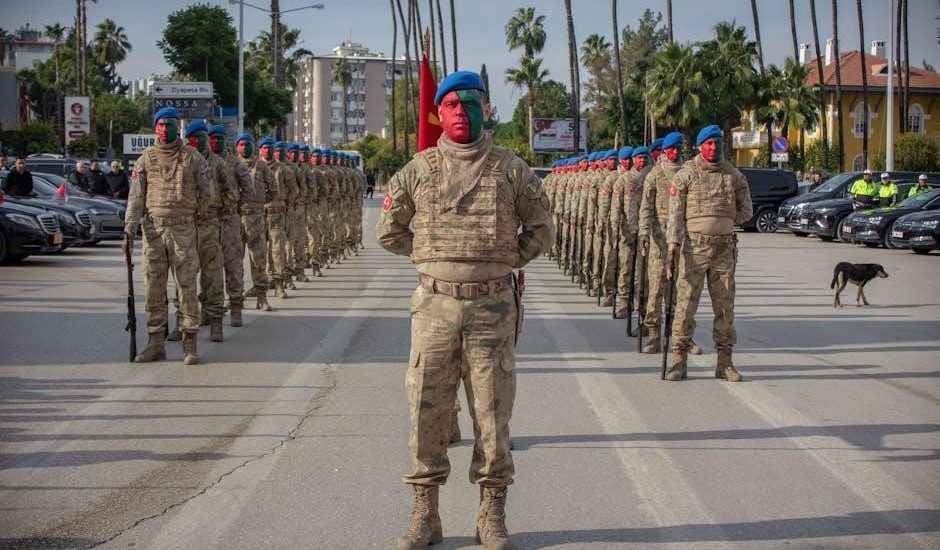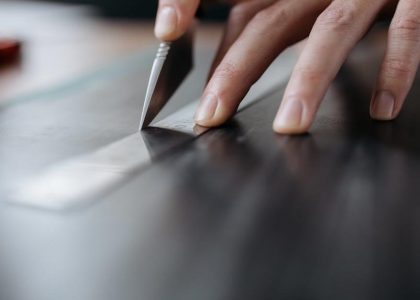The Army Dress Blue Uniform represents a tradition of excellence, transitioning from the Dress Green Uniform in 2014. It symbolizes pride, professionalism, and military heritage, worn during formal ceremonies and significant events.
1.1 Historical Significance of the Dress Blues
The Army Dress Blues hold deep historical significance, tracing back to the transition from the Dress Green Uniform in 2014. Rooted in tradition, the uniform reflects the Army’s heritage, drawing inspiration from World War II-era designs. Its dark blue coat and formal attire symbolize professionalism and pride. Historically, the Dress Blues were introduced to elevate morale and aesthetic appeal, as suggested by Secretary Patrick Jay Hurley. Today, they are worn during ceremonies and significant events, embodying the Army’s legacy and commitment to excellence.
1.2 Importance of the Dress Blues in Military Ceremonies
The Army Dress Blues are integral to military ceremonies, symbolizing professionalism and respect for tradition. Worn during formal events, memorials, and national holidays, they honor the sacrifices of service members. The uniform’s dark blue coat and formal attire emphasize the gravity of these occasions. It is appropriate for both enlisted soldiers and officers, fostering unity and pride. The Dress Blues embody the Army’s values, making them a cornerstone of ceremonial appearances and a visual representation of military heritage and discipline.
1.3 Evolution of the Army Dress Blue Uniform
The Army Dress Blue Uniform has undergone significant transformations, reflecting military and cultural shifts. Originally inspired by earlier uniform designs, it evolved to its current form, becoming the Army Service Uniform (ASU) in 2014. This change replaced the Dress Green Uniform, aligning the Army’s formal attire with modern standards. The uniform’s dark blue coat, white shirt, and black bow tie symbolize tradition and professionalism. Its evolution ensures it remains a respected symbol of military heritage, adapting to contemporary needs while honoring its historical roots.

Components of the Army Dress Blue Uniform
The Army Dress Blue Uniform includes a dark blue coat, matching trousers or skirt, white dress shirt, black bow tie, and the Army Service Cap. These components ensure a sharp, professional appearance, adhering to military standards and tradition.
2.1 The Army Dress Blue Coat
The Army Dress Blue Coat is a dark blue, knee-length garment made from high-quality wool fabric. It features a fitted design with a standing collar, two front pockets, and ornamental buttons. The coat is adorned with branch insignia, rank, and other authorized insignia, reflecting the soldier’s military identity. It is a central piece of the Dress Blue Uniform, symbolizing professionalism and heritage. The coat is worn during formal events, ceremonies, and memorials, embodying the Army’s traditions and values. Proper fit and tailoring are essential to maintain its sharp appearance.
2.2 Dress Blue Trousers and Skirt
The Army Dress Blue Trousers are made from the same dark blue wool fabric as the coat, ensuring a cohesive appearance. They feature a high waistline, strip of satin or braid down the outer seam, and are designed to be worn with a belt. For female soldiers, the Dress Blue Skirt is an alternative, made from the same fabric and designed to be knee-length. Both trousers and skirts must be tailored to fit perfectly, maintaining a sharp, professional look. Proper alignment and pressed creases are essential for a polished presentation.
2.3 The White Dress Shirt
The white dress shirt is a crisp, long-sleeved component of the Army Dress Blue Uniform, made from high-quality cotton or similar fabric. Designed to fit snugly, it features a wing-tip collar to accommodate the black bow tie. The shirt is typically slim-fit to maintain a sharp, professional appearance. Cufflinks are required, ensuring a polished look. Attention to detail is crucial, as the shirt must be immaculately clean and pressed, free from wrinkles or spots. Proper care and maintenance ensure its longevity and contribute to the overall dignity of the uniform.
2.4 The Black Bow Tie
The black bow tie is a mandatory component of the Army Dress Blue Uniform, worn exclusively with the white dress shirt. It must be made of silk or satin, ensuring a polished appearance. The bow tie should be properly tied, not pre-tied or clipped, to maintain professionalism. It is centered under the collar, with edges aligned symmetrically. The bow tie enhances the uniform’s formal aesthetic and adheres to Army Regulation 670-1 guidelines. Proper wear is essential to project discipline and respect for military traditions.
2.5 The Army Service Cap
The Army Service Cap is a midnight-blue, peaked cap worn as part of the Dress Blue Uniform. Made from wool or polyester, it features a sewn-on insignia and a leather visor. The cap is worn at a slight angle, with the visor aligned horizontally. It is required for officers and warrant officers in the ASU and is optional for enlisted personnel. The service cap adds a touch of elegance, completing the formal appearance of the uniform. Proper wear is essential to maintain the uniform’s polished and professional look.
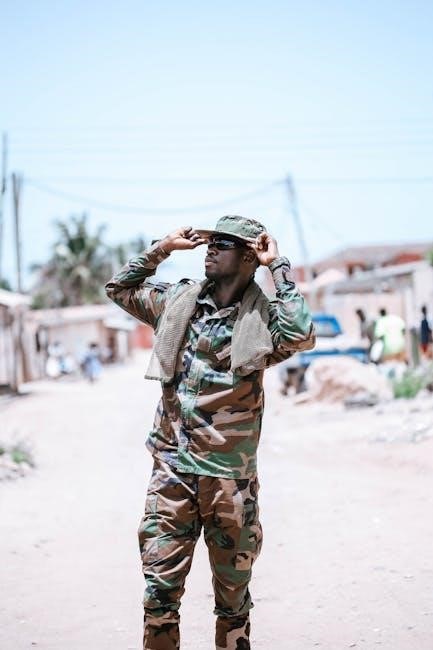
Regulations and Grooming Standards
Army Regulation 670-1 governs the wear and appearance of the Dress Blue Uniform, emphasizing neatness, professionalism, and adherence to strict grooming standards for all soldiers.
3.1 Army Regulation 670-1 Guidelines
Army Regulation 670-1 outlines the official standards for the wear and appearance of the Dress Blue Uniform. It specifies grooming requirements, such as hair length for female soldiers, acceptable hairstyles, and permissible jewelry. Additionally, it details uniform accessories, including shoes, belts, and hats, ensuring consistency across all ranks. Adherence to these guidelines is mandatory, reflecting the Army’s emphasis on discipline and professionalism. The regulation also addresses proper fit and tailoring, ensuring the uniform presents a sharp, military appearance at all times.
3.2 Proper Grooming for Uniform Wear
Proper grooming is essential when wearing the Army Dress Blue Uniform. Hair must be neat and styled according to Army standards, with females keeping their hair tied back if it exceeds shoulder length. Nails should be clean and trimmed, and excessive jewelry is prohibited. Males must maintain a clean-shaven face or adhere to specific beard regulations. These standards ensure a professional and polished appearance, reflecting the Army’s commitment to discipline and tradition. Grooming is a critical aspect of uniform wear, emphasizing personal pride and military bearing.
3.3 Uniform Fit and Tailoring Standards
The Army Dress Blue Uniform must fit impeccably, adhering to strict tailoring standards. The coat should be snug but not tight, with sleeves ending at the wristbone. Trousers and skirts must break slightly above the shoes. Alterations are permitted to achieve a tailored look, but they must comply with Army Regulation 670-1. The uniform should appear clean, pressed, and well-maintained, reflecting professionalism. Proper fit ensures a sharp, military appearance, essential for ceremonies and formal events. Tailoring enhances the uniform’s aesthetic while maintaining its traditional design and functionality.

Occasions for Wearing the Dress Blues
The Army Dress Blues are worn during formal military events, memorial services, national holidays, and black-tie ceremonies, symbolizing respect, pride, and tradition.
4.1 Formal Military Events
Formal military events, such as change-of-command ceremonies, retirement ceremonies, and promotion events, require the wear of the Army Dress Blue Uniform. This attire signifies respect for the occasion and adherence to military traditions. It is essential to ensure all components, including the coat, trousers, shirt, tie, and cap, are correctly assembled and meet grooming standards. Proper display of insignia, ribbons, and medals adds to the uniform’s ceremonial significance. Attention to detail ensures a sharp, professional appearance, reflecting military discipline and pride.
4.2 Memorial Services and National Holidays
The Army Dress Blue Uniform is worn during memorial services and national holidays to honor fallen soldiers and celebrate patriotism. These events, such as Memorial Day, Independence Day, and Veterans Day, require a dignified appearance. The uniform’s dark blue coat symbolizes mourning and respect, while its meticulous design reflects the Army’s legacy. Soldiers wearing the Dress Blues during these occasions embody gratitude, unity, and commitment to national service. The uniform’s formal nature ensures a solemn and respectful representation of military values.
4.4 Weddings and Black-Tie Events
The Army Dress Blue Uniform is appropriate for weddings and black-tie events, blending formal elegance with military tradition. Its dark blue coat, white shirt, and black bow tie create a sophisticated appearance. Soldiers wearing the Dress Blues at such events reflect discipline and respect for the occasion. The uniform’s polished look aligns with the formal atmosphere, making it a fitting choice for celebrating milestones while representing military pride and professionalism.
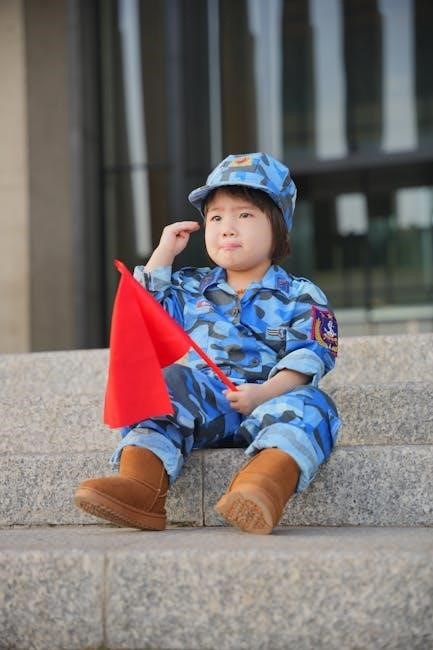
How to Properly Wear the Dress Blues
The Army Dress Blue Uniform requires precise assembly and wear to reflect military professionalism and respect for tradition, ensuring all components align perfectly for a polished appearance.
5.1 Assembly and Placement of Insignia
Proper assembly and placement of insignia on the Army Dress Blue Uniform are essential for a professional appearance. Insignia, including rank, branch, and ribbons, must be positioned according to Army Regulation 670-1. Rank insignia is typically placed on the shoulder loops, while branch insignia is centered on the left side of the coat. Ribbons and medals are worn on the left chest, with miniature medals positioned above the ribbon bars. Badges are placed on the right side, ensuring correct alignment and spacing for a polished look.
5.2 Ribbon and Medal Display
Ribbon and medal display on the Army Dress Blue Uniform must adhere to strict guidelines. Medals are worn on the left chest, centered above the ribbon bars, with miniature medals positioned above full-size ones. Ribbons are arranged in rows, with the most prestigious awards on the left. Spacing between rows and columns is critical for a neat appearance. Soldiers are limited to three rows of medals and four rows of ribbons. Proper alignment and adherence to Army Regulation 670-1 ensure a professional and respectful presentation of achievements.
5.3 Proper Tie and Shirt Alignment
Proper alignment of the black bow tie and white dress shirt is essential for a polished look. The shirt must be snug-fitting, with the collar flush against the neck, and the cuffs secured tightly. The black bow tie is centered under the collar, aligned with the shirt’s top button, and tied symmetrically. Ensuring the tie lies flat and the shirt remains wrinkle-free maintains professionalism. Adherence to these guidelines, as outlined in Army Regulation 670-1, ensures uniformity and respect for military tradition.
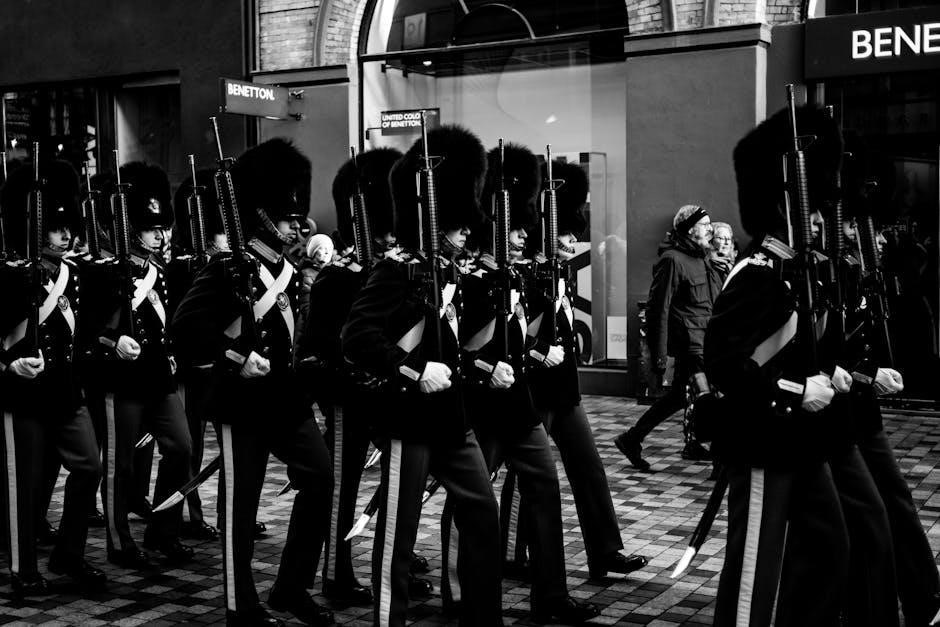
Maintenance and Care of the Dress Blues
Regular cleaning, proper storage, and professional tailoring ensure the longevity of the Dress Blues. Avoid harsh chemicals, store on sturdy hangers, and use cloth covers to preserve quality.
6.1 Cleaning and Laundry Instructions
Proper cleaning ensures the longevity of the Army Dress Blue Uniform. Use mild detergents and cold water to avoid fading. Avoid harsh chemicals, bleach, or fabric softeners. Spot clean stains gently with a damp cloth. For heavily soiled areas, hand wash or use a gentle cycle. Dry cleaning is recommended for complex stains. Iron the uniform while slightly damp, starting with the sleeves and working downward. Avoid direct heat on buttons or insignia. Store the uniform clean and dry to prevent mold or discoloration. Regular maintenance ensures the uniform remains sharp and professional.
6.2 Storage and Preservation Tips
Store the Army Dress Blue Uniform in a cool, dry place to prevent moisture damage. Use acid-free tissue paper to stuff sleeves and preserve shape. Hang the uniform on a sturdy, padded hanger in a breathable garment bag. Avoid plastic bags, as they can trap moisture. For extended storage, consider using cedar-lined closets to deter pests. Fold trousers neatly to avoid creases. Keep accessories like medals and ribbons in separate, labeled containers. Avoid extreme temperatures and sunlight exposure to maintain color and fabric integrity. Periodically inspect for dust or damage to ensure longevity.
6.3 Repair and Alteration Guidance
Repairs and alterations to the Army Dress Blue Uniform must adhere to Army Regulation 670-1. Minor repairs, such as replacing buttons or reinforcing seams, should be done by authorized tailors. Avoid excessive alterations that compromise the uniform’s professional appearance. Ensure all modifications maintain the uniform’s original design and fit standards. Use only approved materials and colors to preserve the uniform’s integrity. Professional tailoring is recommended for precise adjustments, ensuring compliance with military guidelines. Regular inspections can help identify needed repairs early, preventing further damage.

Accessories for the Dress Blue Uniform
Accessories for the Army Dress Blue Uniform enhance its formal appearance. These include medal and ribbon bars, shoulder marks, belt buckles, and polished shoes. Each item must meet Army regulations for placement and style to maintain professionalism and uniformity. Properly securing insignia and aligning accessories ensures a sharp, military presentation. Accessories are carefully selected to complement the uniform’s dark blue fabric, contributing to its ceremonial and formal significance. Attention to detail in accessory wear is essential for upholding military traditions and standards.
7.1 Medal and Ribbon Bars
Medal and ribbon bars are integral to the Army Dress Blue Uniform, showcasing a soldier’s achievements and service. These bars are worn above the right breast pocket, aligned horizontally, and secured tightly. Medals are displayed in order of precedence, with the highest honors first, while ribbons follow a similar hierarchy. The number of medals is limited to three per row, and they must be full-size. Ribbons are mounted on a bar, ensuring they are evenly spaced and parallel to the ground. Proper alignment and securing of these items are crucial for a professional appearance.
7.2 Shoulder Marks and Insignia
Shoulder marks and insignia on the Army Dress Blue Uniform indicate rank, branch, and organizational affiliation. Officers and enlisted personnel wear distinct shoulder marks, with officers’ marks featuring a brighter color. Insignia, such as unit crests or combat badges, are worn on the left side of the coat. Proper placement and alignment are essential, adhering to Army Regulation 670-1 guidelines. These elements enhance the uniform’s professional appearance and reflect a soldier’s identity and achievements within the military structure. Precision in wear ensures uniformity and respect for tradition.
7.3 Belt and Buckle Specifications
The Army Dress Blue Uniform requires a black leather belt with a silver or gold buckle, depending on rank. Officers wear a gold buckle, while enlisted personnel wear silver. The belt must be worn snugly, centered, and aligned with the first button of the coat. Buckles feature the Army emblem or branch-specific designs. Proper wear ensures a polished appearance, adhering to Army Regulation 670-1. The belt and buckle symbolize professionalism and uniformity, enhancing the overall formal look of the Dress Blues during ceremonies and official events.
7.4 Shoes and Socks Requirements
For the Army Dress Blue Uniform, black leather oxfords are mandatory for both males and females. Shoes must be highly polished to a high gloss finish. Socks must be black in color, made of cotton or wool, and pulled up neatly. The socks should not be visible beyond the top of the shoes. These specifications ensure a uniform and professional appearance, aligning with Army Regulation 670-1. Proper footwear and sock wear are essential for maintaining the formal and polished look of the Dress Blues during military ceremonies and events.
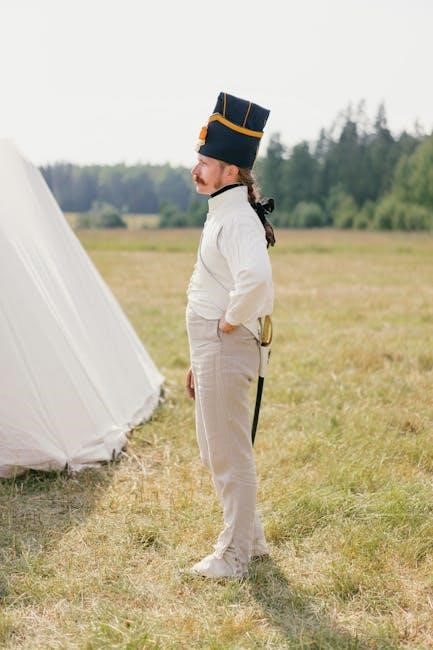
Female Army Dress Blue Uniform
The female Army Dress Blue Uniform features a tailored coat, A-line skirt, and necktab. It emphasizes professionalism and equality, with specific guidelines for accessories and grooming.
8.1 Female Coat and Skirt Differences
The female Army Dress Blue Uniform features a tailored coat with a fitted design and two buttons at the waist. The skirt is A-line, reaching just above the knee, with a 1-2 inch slit in the back for mobility. Unlike the male version, the coat is slightly shorter and nipped at the waist, while the skirt replaces trousers for a feminine yet professional appearance. The white blouse and necktab complete the outfit, ensuring a polished look that aligns with military standards while maintaining gender-specific styling.
8.2 Female Shirt and Necktab
The female Dress Blue Uniform includes a white, long-sleeved blouse made of high-quality cotton or a similar material. The blouse features a stiffened collar to maintain its shape and is tailored to fit snugly, ensuring a professional appearance. The necktab, a black silk or satin piece, is worn around the collar, tied neatly to complete the outfit. Proper fit and alignment are crucial to maintain the uniform’s polished look.
8.3 Hair and Jewelry Regulations
Hair and jewelry regulations for female soldiers wearing the Army Dress Blue Uniform are strictly defined. Hair must be neatly styled, avoiding extreme colors or styles, and kept off the collar. Jewelry is limited to minimal items such as earrings, wedding bands, and watches, which must be simple and inconspicuous. These guidelines ensure a professional and uniform appearance, aligning with the Army’s grooming standards. Adherence to these rules is essential to maintain the dignity and formality of the Dress Blue Uniform.
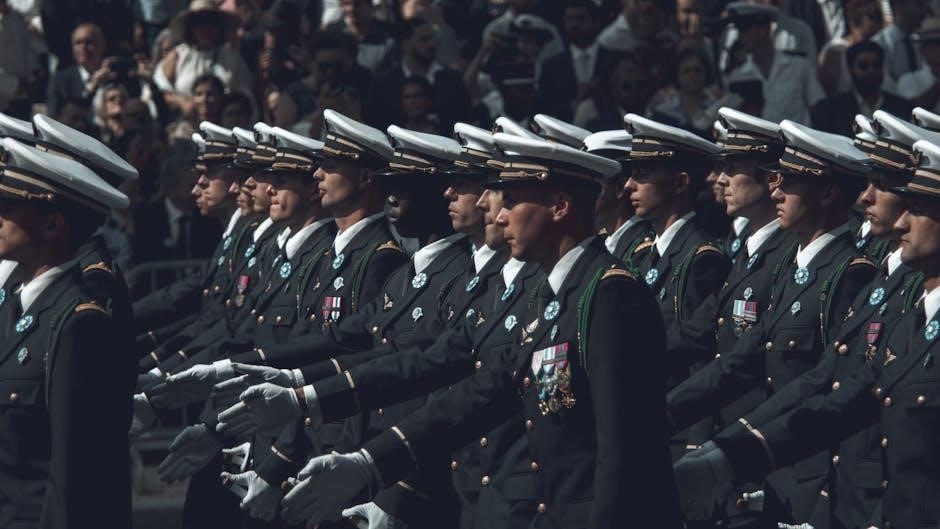
Male Army Dress Blue Uniform
The male Army Dress Blue Uniform features a dark blue coat, matching trousers, white shirt, and black bow tie. It embodies formality and military tradition, worn for ceremonies and official events, reflecting professionalism and pride in service.
9.1 Male Coat and Trousers Fit
The male Army Dress Blue Uniform coat is tailored to fit snugly around the chest and shoulders, ensuring a sharp, professional appearance. Trousers are creased and fitted, breaking slightly above the shoes. Proper fit is emphasized in Army Regulation 670-1, requiring alterations to achieve a precise, military-standard look. The coat’s length should reach the hip, while trousers must align smoothly with the belt and shoes, reflecting attention to detail and adherence to grooming standards.
9.2 Male Shirt and Tie Requirements
The male Army Dress Blue Uniform requires a white, long-sleeved dress shirt made of starched cotton or a similar material. The shirt must fit snugly around the neck and shoulders, with sleeves tailored to reach the wrist when arms are relaxed. The black bow tie is mandatory and must be properly knotted, centered under the collar, and aligned with the shirt’s top button. The tie should lie flat against the shirt, ensuring a professional, polished appearance that adheres to Army Regulation 670-1 standards for uniform wear.
9.3 Male Grooming Standards
Male soldiers wearing the Army Dress Blue Uniform must adhere to strict grooming standards. Hair must be neatly trimmed, with no visible stubble, and kept within the established length and style guidelines. Facial hair is prohibited except for mustaches, which must be conservative and neatly trimmed. Sideburns should align with the earlobes and not extend below the opening of the ear canal. Fingernails must be clean, trimmed, and free of polish. Overall, grooming should reflect professionalism and discipline, aligning with Army Regulation 670-1 standards for uniform wear.
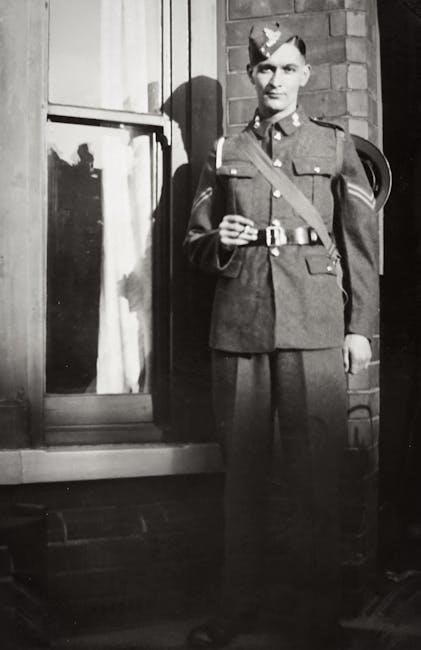
The Army Service Uniform (ASU)
The Army Service Uniform (ASU) represents a modern evolution of military attire, adopted in 2014 to replace the Dress Green Uniform. It is worn for ceremonial and formal events, embodying tradition and professionalism.
10.1 Transition from Dress Green to Dress Blue
The transition from the Dress Green to the Dress Blue uniform marked a significant shift in Army attire, formalized in 2014. The ASU replaced the legacy Dress Green, modernizing the appearance while maintaining tradition. The new uniform features a dark blue coat with lighter blue trousers, streamlining the look for formal events. This change was phased in, with soldiers required to possess the ASU by October 1, 2020. The shift reflects the Army’s commitment to a professional, unified image, blending heritage with contemporary style.
10.2 ASU Wear and Appearance
The Army Service Uniform (ASU) is worn on formal occasions, embodying professionalism and heritage. It features a dark blue coat, light blue trousers, and a white shirt with a black bow tie. Proper fit is essential, with tailored alterations ensuring a sharp appearance. Grooming standards must be strictly adhered to, including neat hairstyles and trimmed nails. The ASU reflects the Army’s commitment to a polished, cohesive look, ensuring soldiers present a dignified image at all times. Adherence to these guidelines is crucial for maintaining uniformity and respect for tradition.
10;3 Distinctions Between ASU and Dress Blues
The ASU and Dress Blues share similarities but have distinct differences. The ASU, introduced as the Army’s formal uniform, features a dark blue coat with a lighter blue trousers or skirt, paired with a white shirt and black bow tie. In contrast, the Dress Blues, while visually similar, are specifically designated for ceremonial occasions. The ASU is more versatile, worn for both formal and semi-formal events, whereas the Dress Blues are reserved for high-profile ceremonies. Both uniforms uphold military tradition but serve different purposes in Army protocol.
The Army Dress Blue Uniform embodies military tradition, excellence, and professionalism, serving as a timeless symbol of service and pride for soldiers in formal and ceremonial roles.
11.1 Final Tips for Maintaining Excellence
Regularly inspect your uniform for wrinkles, stains, and wear. Store it in a cool, dry place to preserve its color and fabric integrity. Ensure all insignia and ribbons are correctly aligned, and avoid over-dry cleaning to maintain its finish. Pay attention to grooming standards to complement the uniform. These practices uphold the Army’s tradition of excellence and discipline, ensuring your Dress Blues continue to reflect professionalism and pride in military service.
11.2 The Role of the Dress Blues in Modern Military Tradition
The Dress Blues remain a cornerstone of modern military tradition, symbolizing resilience and continuity. Transitioned from the Dress Green Uniform in 2014, they honor the Army’s legacy while adapting to contemporary customs. Ceremonial events and formal occasions showcase their significance, connecting soldiers to a lineage of service and sacrifice. The uniform’s dark blue coat and precise styling reflect the Army’s commitment to tradition and excellence, ensuring its enduring role in military culture and identity. It bridges past and present, embodying the values of the U.S. Army.

